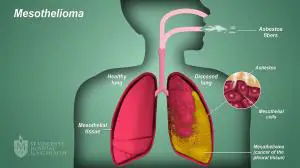The Top 5 U.S. States with the Most Deaths from Mesothelioma
| U.S. State | Mesothelioma Mortality Rate | |
|---|---|---|
| 1 | Nevada | 1.382 |
| 2 | Michigan | 1.065 |
| 3 | Arizona | 1.029 |
| 4 | Louisiana | 1.013 |
| 5 | Wisconsin | 0.978 |
 Special Report
Special Report
What is Mesothelioma?
Mesothelioma is a rare type of cancer that is caused exclusively by asbestos exposure. That is to say that only people who have been exposed to asbestos at some time in their lives are at risk of getting Mesothelioma.
Malignant Mesothelioma is a very complex, and thankfully, rare type of cancer accounting for an estimated 0.17% of all cancers in the United States in 2018. Because symptoms are mostly non-specific there is often a long delay in diagnosis allowing the cancer to spread.
Pleural mesothelioma, tumors found in the lining of the lungs, is the the most common type, accounts for almost 90% of all cases, and is normally found in men in their 60's and 70's. Unfortunately, even with today's advanced research and improvements in medical technology, malignant pleural mesothelioma has a high incidence of mortality with a 5 year survival rate of only 12.1%. Because Mesothelioma has a long latency period, anywhere from 10 to 70 years, deaths are now reaching their peak in people who worked with the material during the 1950's, 60's and 70's and asbestos exposure continues to this day.
Indeed mesothelioma kills an estimated 100,000 people worldwide and in the United States an estimated 2,000 to 3,000 people die from this cancer every year due to asbestos exposure at some point in their lives. In some countries such as Great Britain, the death rate from mesothelioma is reaching crisis levels. (A). (B.) (C.)
The Asbestos connection
Mesothelioma is basically a modern industrial disease. It is one of only a few conditions are caused almost exclusively by occupational exposures. Included in this group along with malignant mesothelioma is coal-workers’ pneumoconiosis, asbestosis, and silicosis. Mesothelioma is a cancer caused by exposure to asbestos in industrial or construction settings like mining, housing construction, shipping, the aircraft industry, plumbing, etc.
Asbestos is a fine, soft mineral made up of thin fibers that have properties that make it resistant to heat, electricity and corrosion. These properties make the mineral very useful in construction and industry but it is those very properties that make the mineral so toxic and carcinogenic to humans. Although the link to asbestos and cancer had been suspected before, it was German researcher H. W. Wedler that first linked pleural tumors and asbestos in two reports in 1933 but because of the rise of the Nazi party in Germany at that time, the reports were virtually ignored by the international community of scientists. Nowadays, Wedler is considered to be the first scientist to identify pleural cancer as an occupational disease in asbestos workers. (D.)
Research continued throughout the 1950's and 60's but unfortunately so did worker exposure to asbestos. It wasn't until the 1970's that countries around the world began to issue warnings about asbestos in the workplace. The United States issued a warning about asbestos when it issued the Clean Air Act of 1970, classifying asbestos as a hazardous air pollutant and gave the EPA the power to regulate the use and disposal of asbestos (E.). Today more than 50 countries around the world ban asbestos. Britain banned The import and use of blue and brown asbestos in 1985, while white asbestos, was banned in that country in 1999 (C.). Canada banned asbestos only as recently as 2018. Although the mineral is heavily regulated in the United States it is not entirely banned as it is still used in hundreds of products such as roofing material, fireproofing materials, gaskets, etc. (E.)
Conclusions
Although there have been improvements and advancements in mesothelioma treatments over the last decade in the United States, the mortality rate from this disease is still very high. The survival rate of Pleural mesothelioma for 5 years is 12.1% while the 10 year survival rate is a mere 5% with the survival rate in men being lower than that of women. Men have a higher incidence of mesothelioma in general, due to the fact that men traditionally worked in industries where asbestos exposure was a hazard, however even considering the occupational hazard factor, women still have a significantly higher survival rate than men across all ages.
Indeed mesothelioma presents almost exclusively in white males, partly because this ethnic group traditionally held jobs in heavy industry in the past where asbestos was commonly used (F.). As of today's writing there are no plans to ban asbestos entirely in the United States.
Top 5 facts sources:
A. Selby, Karen. (2020). The History of Mesothelioma. Retrieved from: Asbestos.com: "Mesothelioma history"
B. Molinari, Linda. (2020) "Mesothelioma Statistics & Facts". Retrieved from: https://www.mesothelioma.com/mesothelioma/statistics/
C. Perraudin, Francis. (2019). "Britain’s death toll from asbestos at crisis level, figures reveal." Perraudin, Francis. (2019). "Britain’s death toll from asbestos at crisis level, figures reveal." Retrieved from: https://www.theguardian.com/society/2019/jul/07/britains-death-toll-from-asbestos-at-crisis-level-figures-reveal#
D. Berger, Stephen. L., Castleman, Barry. L. (2004). "Asbestos: Medical and Legal Aspects." Aspen Publishers. USA.
E. Lahav, Joseph. (2020). "No Asbestos Ban in the US." Retrieved from: https://www.asbestos.com/mesothelioma-lawyer/legislation/ban/
F. Selby, Karen. (2020). "Mesothelioma Survival Rates." Retrieved from: https://www.asbestos.com/mesothelioma/survival-rate/
Sources: WONDER Online Database. Centers for Disease Control and Prevention and National Cancer Institute; 2019. Accessed at http://wonder.cdc.gov/CancerMIR-v2016.html on Jul 5, 2020 5:31:46 PM
List Notes: Data is the Top 5 Mortality Incidence Rate Ratios for Mesothelioma ranked according to U.S. state: 1999 - 2016, WONDER Online Database. United States Department of Health and Human Services, Centers for Disease Control and Prevention and National Cancer Institute; 2019. Accessed at http://wonder.cdc.gov/CancerMIR-v2016.html on Jul 5, 2020 5:31:46 PM

